F1 2017 Overtakes Everything Else
Feral Interactive has been good to us racing games fans. After GRID Autosport, F1 2015 (unfortunately an average game) and the recent Dirt Rally (as reviewed), here is a new Codemasters game landing on Linux (after the Mac/Metal client). A bit of background on this port: when Feral announced they would not port F1 2016 to Linux despite them making a Mac port, quite a few folks expressed their disappointment on social networks such as Reddit - Feral’s rationale was that F1 2015’s sales were kind of disappointing, but Linux gamers had a counter argument: it wasn’t a good F1 game to start with, so Feral should not write F1 games off just because of one data point. Apparently Feral folks were receptive enough to try again their luck with F1 2017. Let’s hope it will be worth it for them this time - since F1 2017 is a much better game than F1 2015 in the first place.
We have a lot of ground to cover. Let’s start first with the obvious: do you have what it takes to play the game on Linux, hardware and software-wise? You should know that the Linux port only features a Vulkan renderer (no OpenGL this around, this is a first for Feral - and maybe a first for Linux gaming in general), so if you are a nVidia gamer like me, you will need at least GPU series 600 and above, and recent drivers - because nVidia does not provide any Vulkan driver for older GPUs. This may not be a major problem, however, since you would anyway need a relatively powerful GPU for this game to run properly. On the AMD Front, you have to rely on the Open Source drivers with Mesa, as long as you use the more recent libraries. See below what was communicated by Feral. Oh, and Intel is not supported, but that’s hardly a surprise for this game.
Minimum:
- 3.3Ghz Intel Core i3-3225 processor
- Ubuntu 17.04
- 4GB RAM
- 2GB Nvidia 680, driver 384.90 or later.
- 3rd Generation AMD Graphics Core Next (Volcanic Islands), Mesa drivers 17.2.2 or later.
For best performance:
- 3.5Ghz Intel Core i5-6600K
- 8GB RAM
- 8GB Nvidia 1070 graphics card, driver 384.90 or later.
Note that there are two points of interest in the specs mentioned by Feral:
- SteamOS is not even called out. Did they just forget, or it’s just fallen out of the radar because of low usage? Oh, and the Ubuntu 17.04 part is not a hard requirement. I have had the game run just fine on Linux Mint 18.3, which is based on Ubuntu 16.04 LTS. Don’t upgrade just for this game, it’s not necessary.
- No recommendation for “best performance” with AMD - does that mean there is still a large gap on Linux vs what nVidia can deliver with the GTX1070? Since we do not have AMD hardware to test, we will have to wait for the community to provide us with an answer.
Now on to what really matters. F1 2017 is a much better game than F1 2015 simply because it has a career mode. This mode is where you are likely to spend most of your time, and honestly, you should. It’s almost designed like a RPG: you get in the shoes of a new pilot joining the F1 2017 season, trying to make a dent in the current competition. All other opponents are the usual F1 drivers that you get to see on TV - thanks to the official F1 licensing. Everything begins with selecting your driver’s look, its portrait, and deciding for which stable to run for.
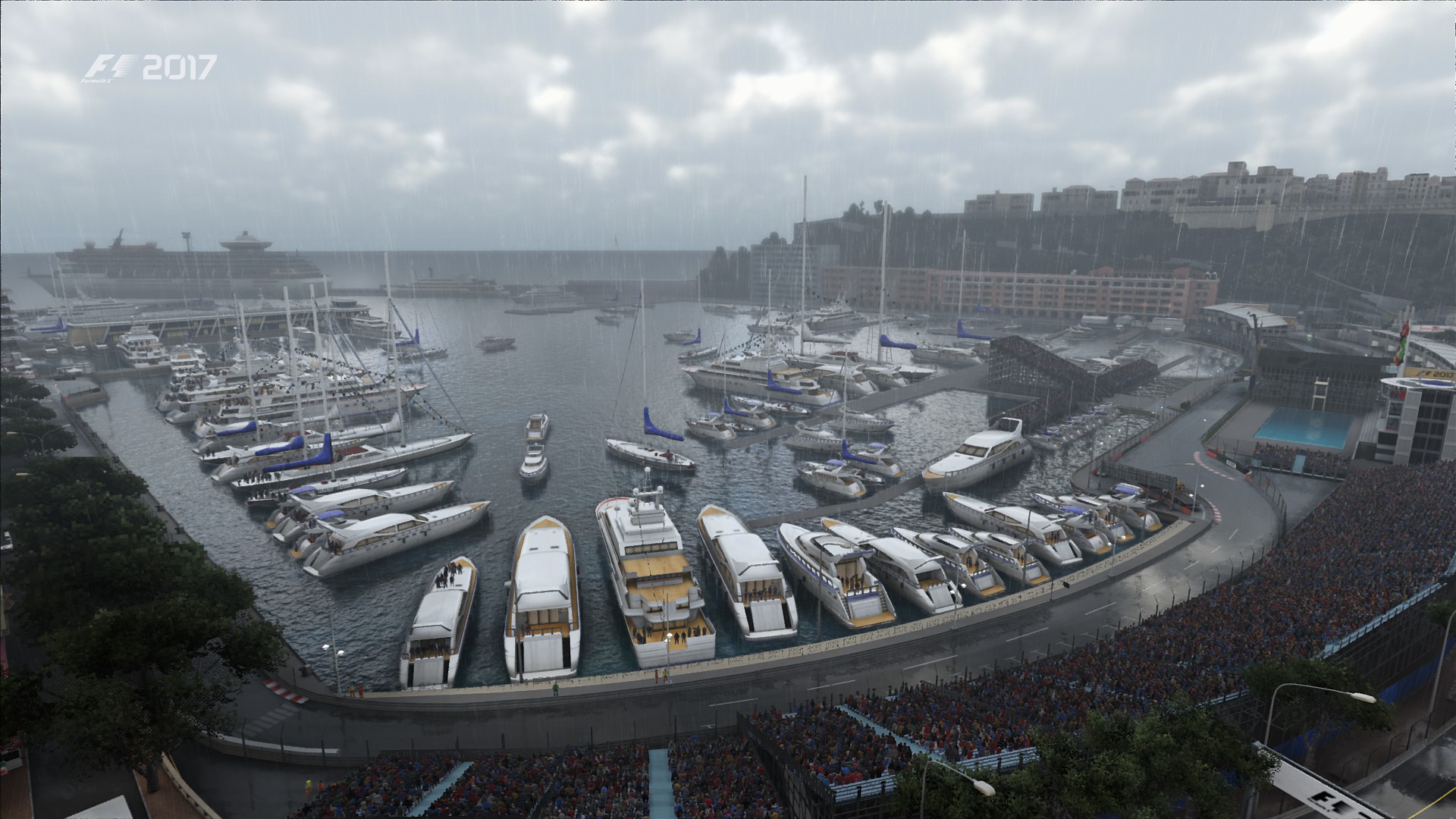
Because the setup is kind of RPG-like, you don’t just jump from one race to the next - there are some kind of cut-scenes introducing you to the team manager, the R&D head, and various sponsors interested to recruit you for one-off events out of the main competition. Such cutscenes are in first-person view mode and offer very little interactivity - if you remember Dirt 2, it’s a little bit like that - this also reminds me of what Turn10 did in the recent Forza Horizon. Such scenes do feel a bit awkward. Characters are far from looking real, stuck somewhere in the uncanny valley. Don’t expect any quality acting either. This feels a little “meh”, but it is not a huge part of the game. So let’s say it is not super important.
Before each race begins, you will get to participate in 3 practice sessions and one qualifying one. Frankly, I have never really liked the idea of practice sessions in racing games. That is usually where game designers spend the least amount of time on. The usual practice mode is one car on an empty track, and man, is it boring. Well, I am glad to say this is not the case at all with F1 2017. This feels a lot more like what’s happening in reality when F1 drivers test the waters.
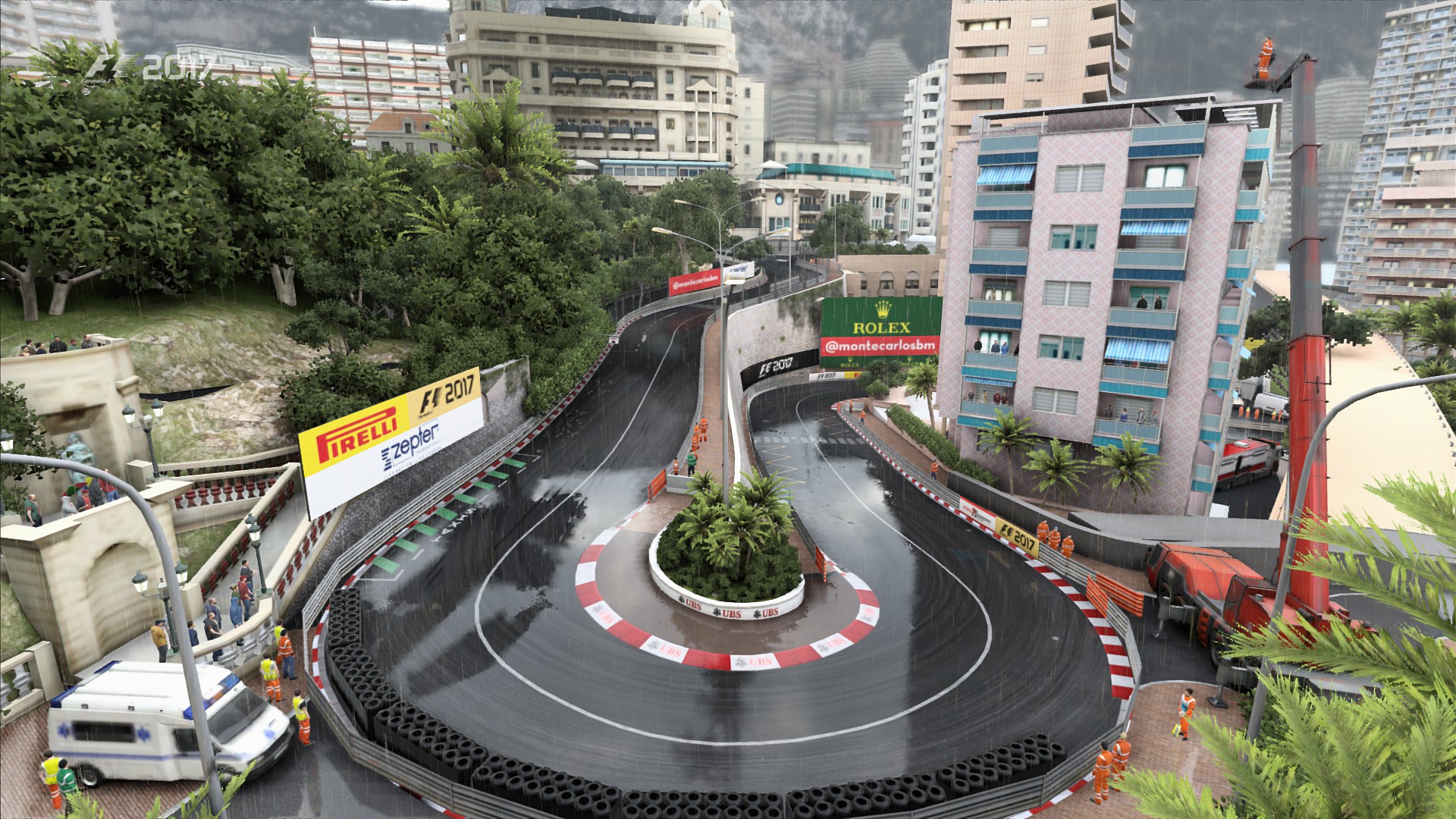
The practice mode is here to make you familiar with the circuit at hand, as one can expect, but there are several additional programs to complete in order to make the most of your time on the track. You can’t laze around here, you only have 30 minutes allocated for each practice session. For example, you can decide to spend a few laps to monitor and optimize your fuel consumption, or focus on tire wear and its management. You will get advice in real time from your stable about your performance and how you should adapt your driving to make the most of your equipment. Going as fast as possible is not a good strategy in Formula 1, as you may already know. Formula 1 races are quite long, and akin to marathons rather than sprint races. Reducing your acceleration in curves, using brakes less violently, will go a long way to make your tires and other parts last longer. That is precisely why practice is pretty much essential - pushing the boundaries of your machine, but in a reasonable, controlled way.
Another nice addition is the race strategy optimization program, which basically tracks your overall car fuel consumption, tire usage and a few other things across several laps to define what should be your race strategy in terms of pit stops. Should you equip stronger tires that last the whole race, while they have less grip, or softer ones that will use up fast and require one or two pit stops during the actual race? Should you go really, really fast, accept the car damage and stop 3 times instead of twice? Several charts will help you extrapolate the impact of your decisions, so that can make an educated choice. That’s what it is all about. Such decisions will have a tremendous influence on the race outcome… more on that later.
When you are well acclimated with the track and how to manage your vehicle, you can turn to qualification practice to ensure you get the best lap time before the actual qualification session.
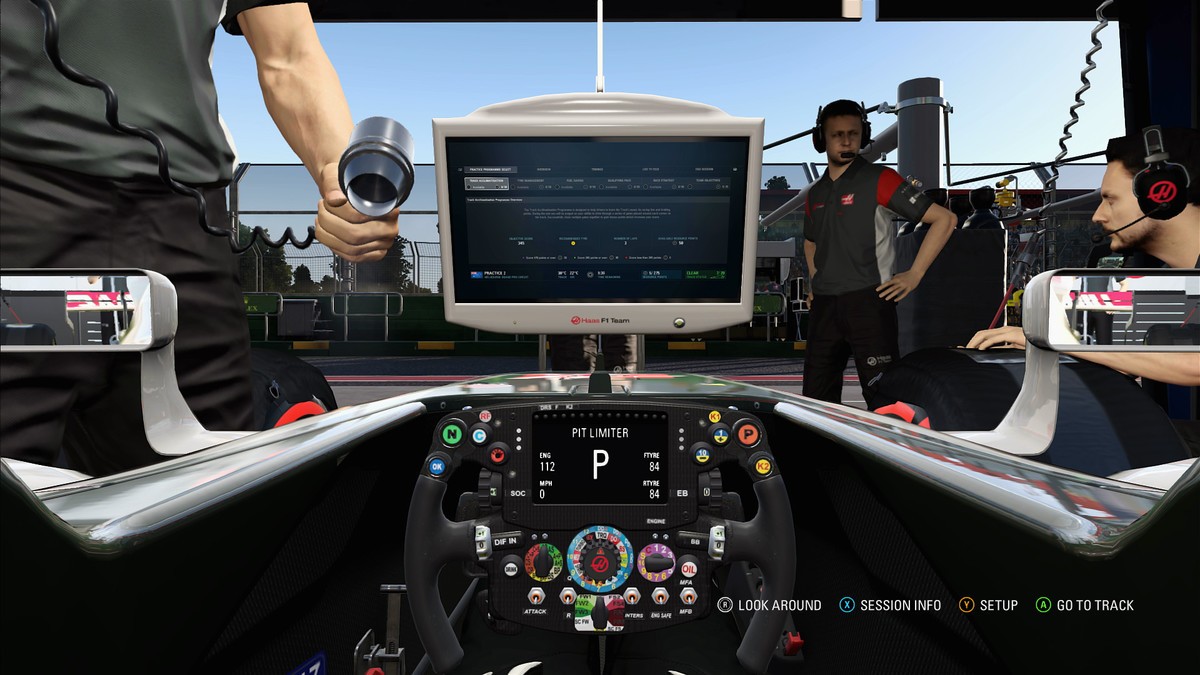
Since there is so much to do in practice sessions, you will soon find out that 30 mere minutes are not sufficient to complete everything at once. Therefore several practice sessions make complete sense to accumulate data and refine your strategy or your driving before the race. This is really an excellent mode that captures well the thinking that goes behind a F1 race: it’s as much about preparation as it is about driving skills. They could have stopped there and it would already be great, but Codemasters went above and beyond, by simulating the practice sessions of other drivers on the track at the same time. Sometimes you won’t be able to complete a program as well as expected because you were slowed down by other cars in front of you. There’s even a tab to check how “busy” the track is at the moment. This is just very, very well done.
Another important factor you need to take in account is that your stable has a limited amount of car (mostly engine) parts, whether it’s for racing or for any kind of preparation before the race. Therefore, the longer you use them up, the shorter the lifetime of each one of them - for the whole season you are only allowed to have 3 additional replacement parts for each engine component - so you need to watch out how fast you go through them from one race to the next. While you may want to spend more time in practice, there is no good reason to do so if you feel ready - you can just put an end to the practice session and go for qualifying directly, and save some of the wear on the engine parts.
In order to motivate you to try out all the activities, the practice mode will reward you with some points for every program completed, and how well they were achieved. Such points go back into the R&D progress tree, which happens to look like it came from the Witcher’s games! Since the game cannot simulate the R&D side of things, a level up tree is actually a good idea to provide some improvements by “guiding” your team towards what you think is important for your success.
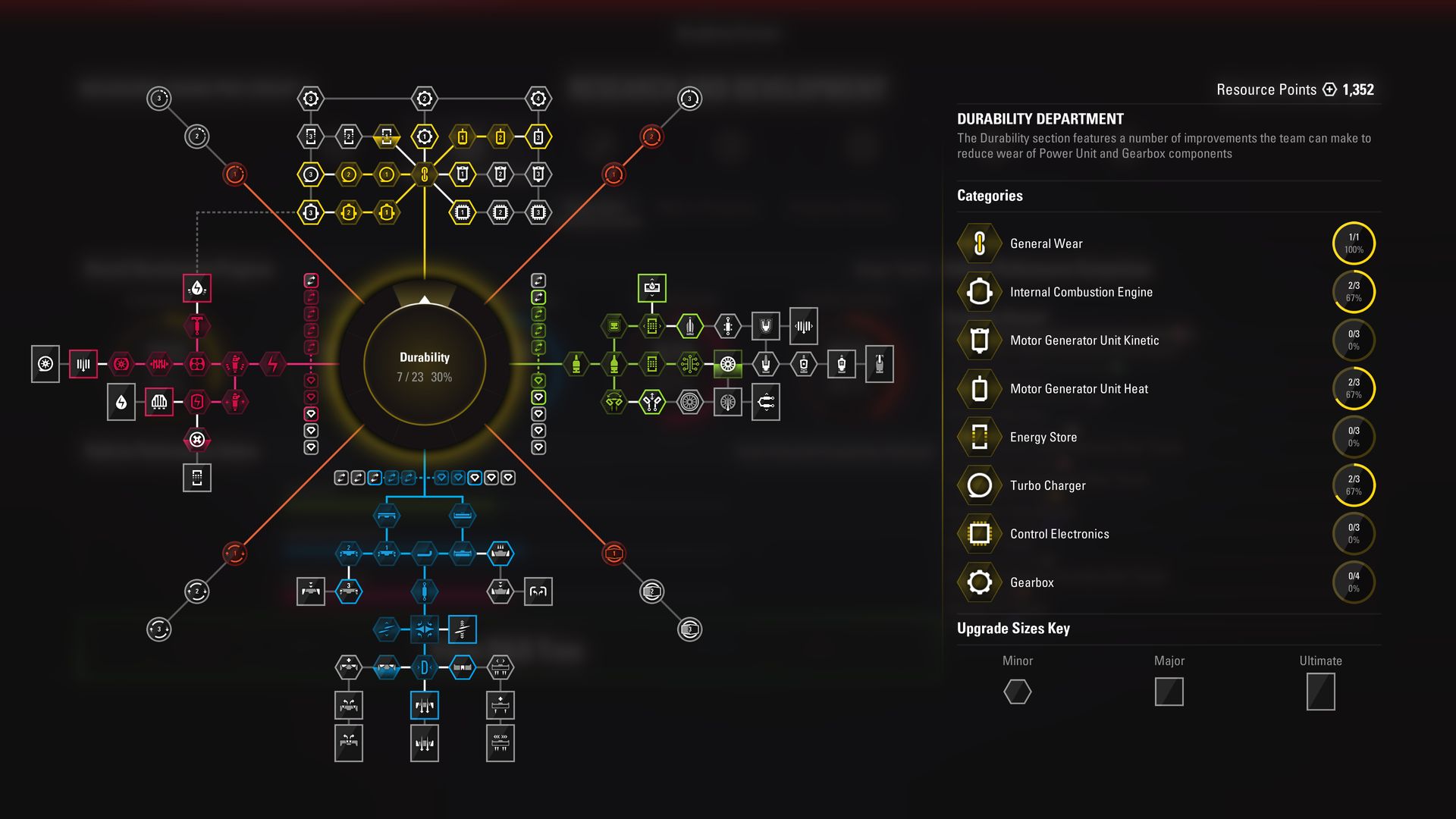
The career mode spans over 10 seasons (so… 10 years!), so if you are really into it, you could spend hundreds of hours in such a mode. This is also what I mean by RPG aspects: the game does not really end after one season, you can decide to continue with your pilot, and based on your performance you may get offers from other racing stables. Such opportunities lead you to more powerful cars if you wish. The initial choice of racing stables impacts what is expected from you. The more prestigious the team, the more often they will expect you to be on the podium - they see you as an investment. Less famous ones will be happy with you being somewhere in the top 10 at the end of the race. So it’s pretty much up to you to decide the level of challenge and what matches your skill the best.
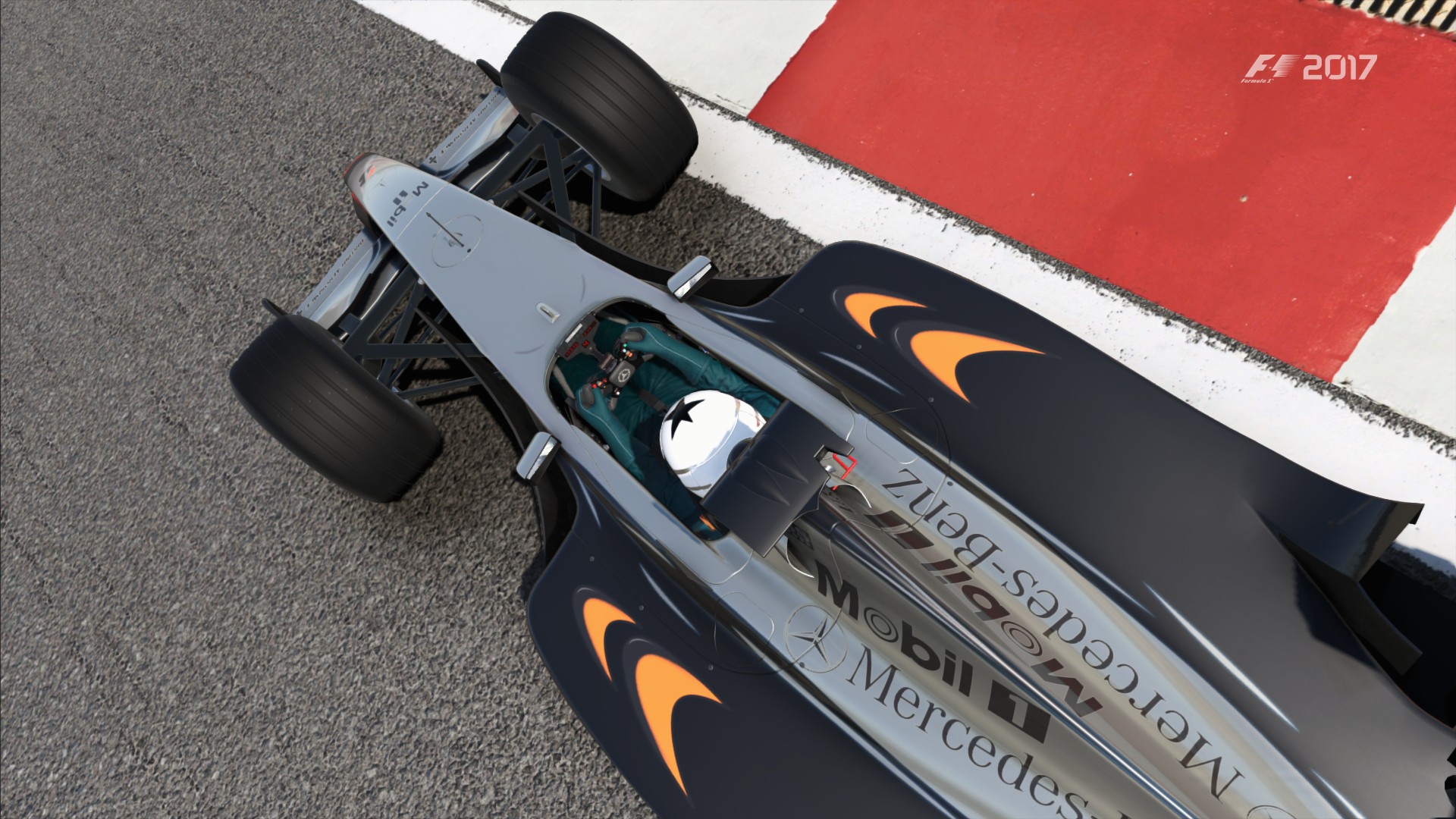
F1 2017 further gamifies this whole career thing by introducing rivals. Rivals are chosen to be slightly above your team’s expectations - and all your results, including your practice sessions’, will be scored against your rival’s. At every stage you will have a good idea if you are losing or winning the rivalry thru several charts and metrics. Again, this was not really necessary in a F1 game, but it’s a good idea to incentivize progression and challenge the player further, even if they don’t make it to the podium in their first few races.
I could talk all day about the depth of the different options offered by F1 2017, but it would not really amount to much if the core component, i.e. the driving, would suck. Fortunately, it does not. It’s actually rather good. It ‘feels’ right. I cannot say if it is actually realistic since I have never had the change to drive a Formula 1 car outside of my dreams, but based on what we know of such cars and how they look on TV in different driving conditions, it definitely does not feel off.
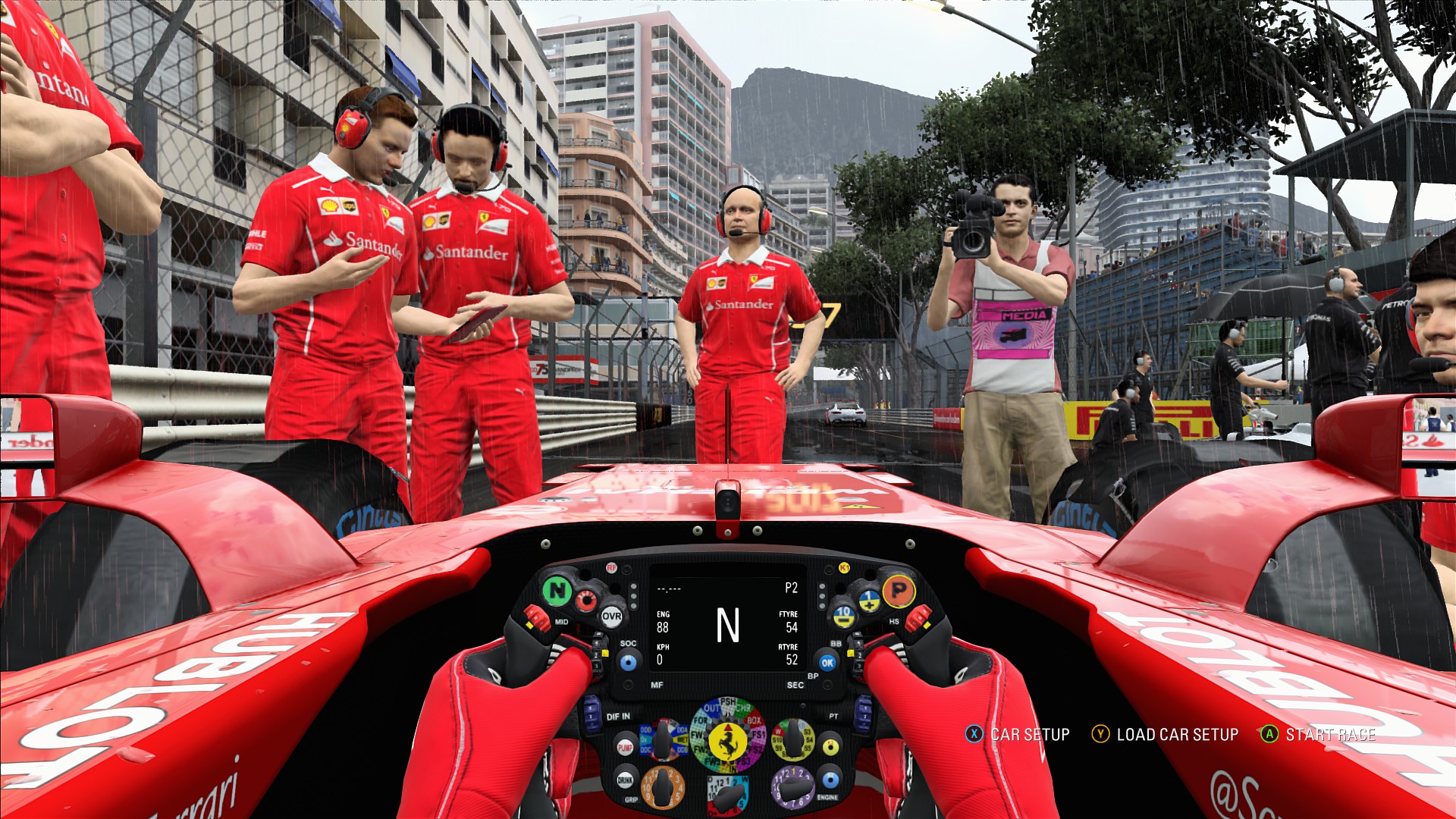
Using default settings, you get a number of assists as well as trajectory/speed recommendation on screen (both of which can be turned off) with a nice 3D effect which makes it come alive more than in the other racing games. With such default settings you will not have to worry too much about losing control of your car, but you will still have to focus on being fast and taking your curves well, unless you want to lose precious seconds every lap. Races are pretty long by simulators’ standards, with about 15 laps by default. That makes each race last a good 20 to 30 minutes. You will feel pretty quickly the tire wear and realize how much it affects your driving. Taking sharp turns will progressively become more challenging and your acceleration will be somewhat diminished. Hence the reason to go back to the pits, and get 2 new pairs of fresh tires when you are on the edge. During the race you can communicate with your stable to ask for information, change the race strategy, or tell them when you want the pit open as you plan to stop sometimes soon. You can also control the richness of the fuel injected in your engine, so that you can optimize for speed or duration.
Opponents will usually follow their own strategies, stopping at least once during the race, but not necessarily in the same lap as yours. It makes for tense moments when you lose the pole position because you misjudged the state of your tires, or went out too early or too late.
In the below video (captured from beta footage, which may not be representative of the final release quality), you can see a whole race, and how I managed to hold the second spot until the very last lap, then lost 3 places to end 5th, just because I misjudged how much fuel I had left. Yes, there’s very little buffer unless you plan for it. More fuel makes your car heavier and therefore slower. It’s all a massive trade-off between conflicting priorities.
Tire wear, while planned and expected, is not your only problem. Collisions should be avoided as much as possible. Unlike most racing simulators, F1 2017 is pretty unforgiving in that regard. Any damage to your front wing will make your car way harder to control and much slower. Everything is so brittle that you need to take extra care when you plan to overtake someone else. Should damage occur, a new pit stop would be required - making it a lot more likely you would finish in the lasts few places. In more realistic settings even small collisions have disastrous consequences - I can’t speak for the validity of the physics engine when it comes to collisions, but Formula 1 cars are well known to be quite fragile so it does not seem too far fetched.
Another reason why F1 2017 is a joy to play is the fact that it accommodates typical controllers (Steam Controller in my case). If you remember my review of Dirt Rally, one of my main complaints was that Dirt Rally was really hard to play using only a gamepad (but apparently very good with a racing wheel). F1 2017 is just perfect with a gamepad, as if it was made for it (which is probably true anyway as consoles were a primary platform). So I have no hesitation to pick it up to play anytime, and I know that any mistake I make is really my fault and there is nothing else to blame.
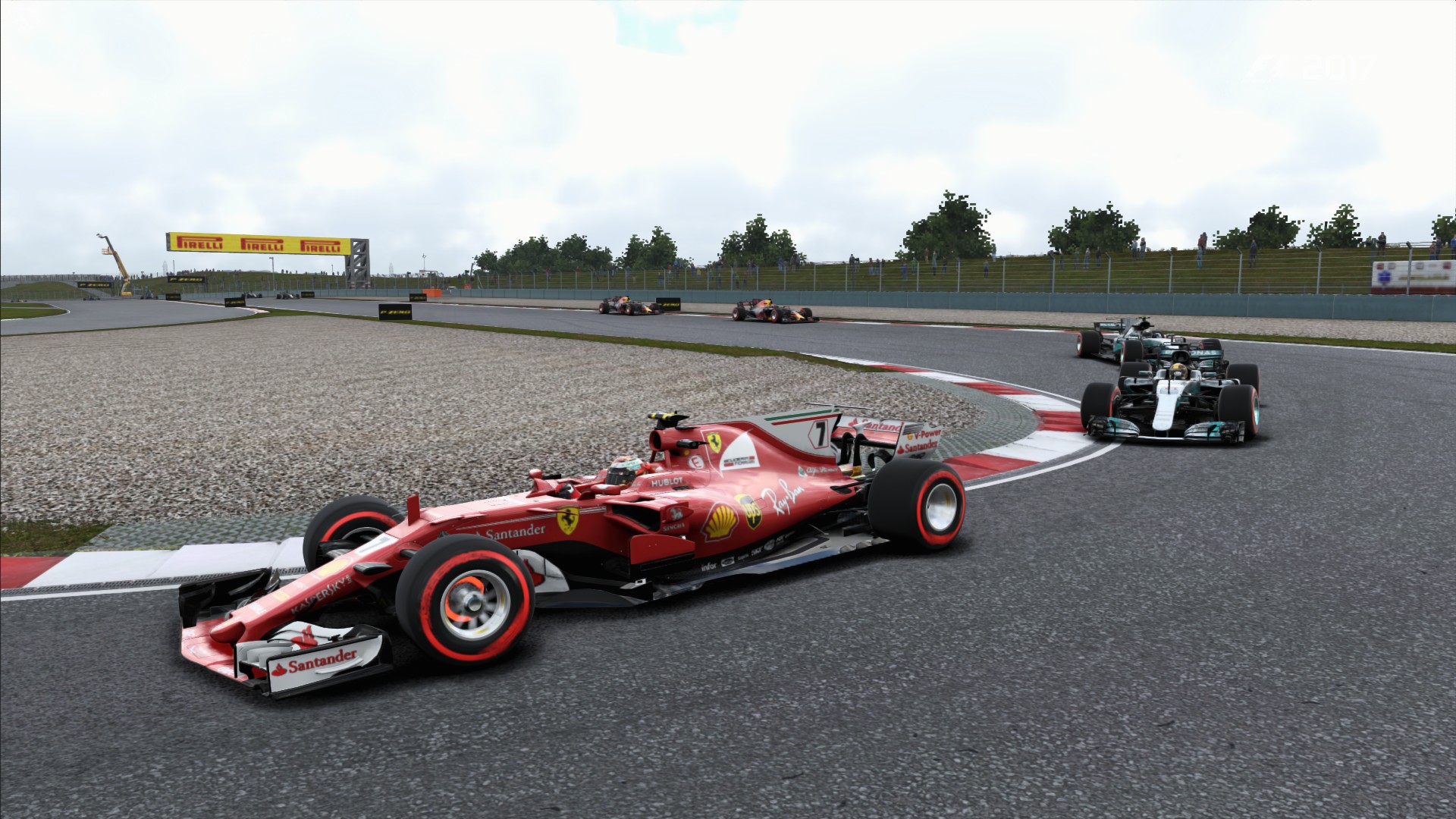
The career mode is a lot of fun. Seriously! Compared to games like GRID Autosport where you don’t really need to do much (you still need to drive), F1 2017 is like a mix of driving and management game in one pack. So many things can occur during a race, that you cannot just expect to know how things will end ahead of time. I have been playing car simulators since the 8 bits era and it’s been a while I haven’t been excited by a driving game.
Should the career mode bore you, you can always go ahead and play head to head against other humans in multiplayer mode. The good news is that even in the beta mode, I could easily find servers to connect to, full of players. While I cannot say for sure, this seems to indicate multiplayer is already cross-platform from the get go, (hopefully not just Mac/Linux, but Windows/Mac/Linux) but we will have to wait for Feral to give us an official answer on that.
I have barely touched at how the game looks - by now you should have seen a large amount of screenshots, and you can judge by yourself. It’s certainly very nice, especially cars and buildings alongside circuits. There are some times camera angles are placed in such a way it almost looks like TV (before a race for example), with pilots wearing their helmets, waiting in their cars - not far from being photo-realistic. Weather effects are great too and driving in heavy rain is just a feast for eyes (and a headache since you can’t see much). As I said previously the human models are still somewhat lacking, but about everything else is top notch.
But does it run well?
As surprising as it sounds, Feral decided to go all in with Vulkan for this release, and while I am not sure how the game would perform vs a hypothetical OpenGL renderer, at least it feels very smooth and solid on Linux. With a GTX 970, on high presets, I get consistently more than 60fps (sunny conditions on track). This means I can play in 1080p with Vsync activated at 60 fps and it would run just beautifully from beginning to end.
- Intel(R) Core(TM) i5-4460 CPU @ 3.20GHz, 8GB RAM, GeForce GTX 970 4GB
- Track: Melbourne, Clear Weather
- Details: High preset, 1080p, VSync Off
- Minimum FPS: 68 fps
- Average FPS: 93 fps
- Maximum FPS: 114 fps
I tried Ultra Settings as well on the same hardware, and the game hits 60 fps on average, but not consistently, which means that with Vsync on you would be switching between 30 fps and 60 fps based on whatever is rendered on screen. For Ultra Settings at 1080p, I am thinking you would probably be fine with a 980Ti and above. I can’t say I noticed a huge difference in graphics quality when driving vs the High settings.
- Intel(R) Core(TM) i5-4460 CPU @ 3.20GHz, 8GB RAM, GeForce GTX 970 4GB
- Track: Monaco, Clear Weather
- Details: Ultra High, 1080p, VSync Off
- Minimum FPS: 51 fps
- Average FPS: 60 fps
- Maximum FPS: 71 fps
Of course, track conditions matter as well when it comes to framerate, and heavy rain will add reflections in puddles and rain fumes behind racing cars. This is not a free lunch and I saw a solid 10 to 15% fps drop versus the clear sky conditions. But doesn’t it look nice! Yes, this is an in-game screenshot below.
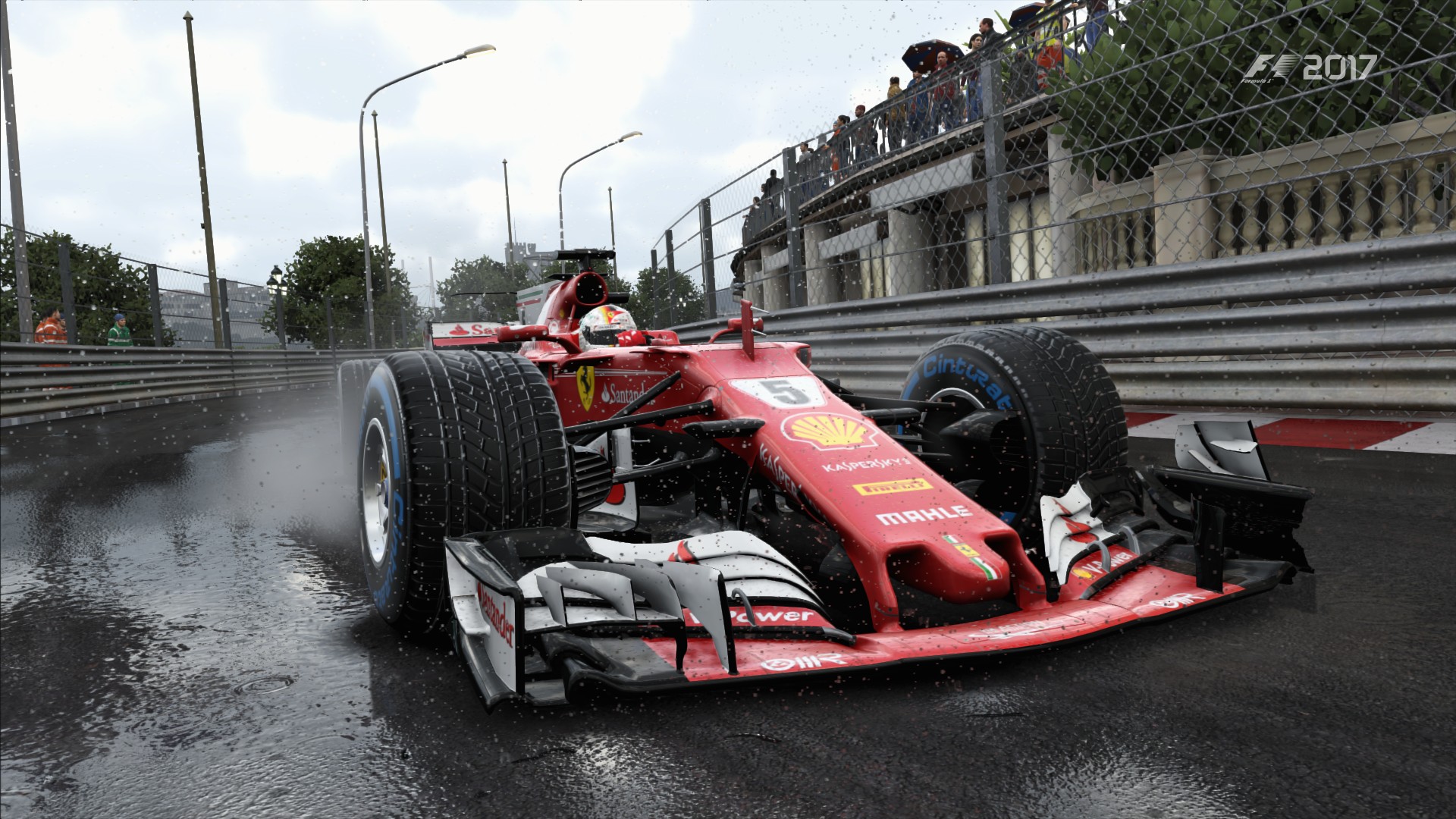
Now, two good piece of news regarding performance.
First, based on several benchmarks seen for Windows for pretty much equivalent hardware to mine, I can say with confidence that the gap in framerate between the Linux and Windows version seems to be minimal. We are talking about something like 10~15% framerate difference (in favor of Windows, as usual), which is probably one of the better ports of Feral ever did in that regard. It’s a testament to the maturity of Vulkan drivers, and the work done by Feral on their Vulkan renderer throughout the course of this year after their first experiment with Mad Max.
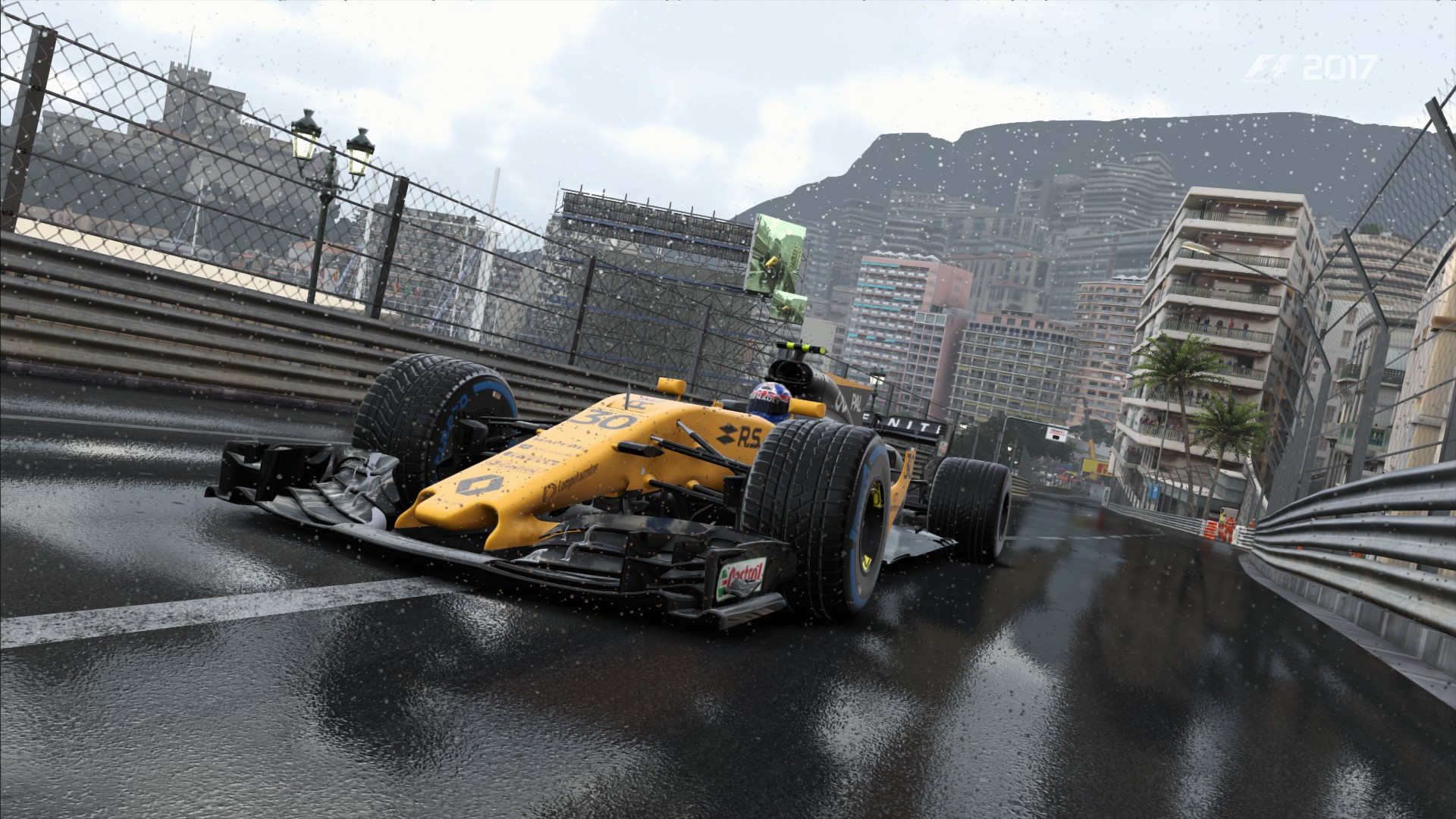
Second, I happen to have another nVidia system to test the game. With a beefier CPU (Xeon 6 cores at 3.47 Ghz) but a weaker GPU (GTX 660 Ti) and a ton of RAM (24 GB). And guess what? That system was able to make the game run at High settings at 60 fps on average (clear sky conditions). I was very impressed that such an old GPU can get so much performance out of this game. For some solid 60 fps at 1080p, you would have to go between medium and high settings, but it will still look pretty much fantastic even with a few effects deactivated. This PC is running SOLUS by the way, and if you use that distro and experience some crashes at startup, you may have to install a specific vulkan-related library (search for “vulkan” in the software manager - The ICD loader).
Phew. This was a long review. But this game deserved it. This is one of the best titles of 2017 for Linux, period, and a must-have for anyone who enjoys racing games - even if they are not into Formula 1. Add to that the very impressive work done by Feral on the Vulkan renderer, and there should be no reason to miss this one. The career mode guarantees almost unlimited replay value - it’s the Civilization of driving games.
Now, Feral, you know what you have to do: Dirt 4 please!
And this is another title for the Recommended Games List, right there in the Racing Games category.
Note on illustrations: The video was captured on Linux with OBS using the NVenc encoder (it has some impact on performance, while minimal). Screenshots are mostly ours, except for the upgrade tree one (Codemasters) and the practice session cockpit view (Xbox One screenshot).
